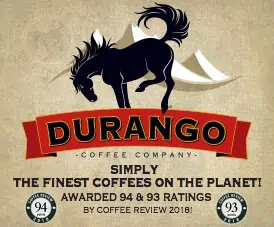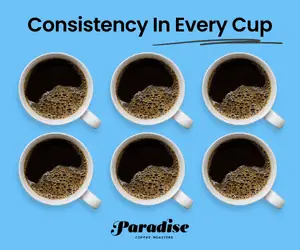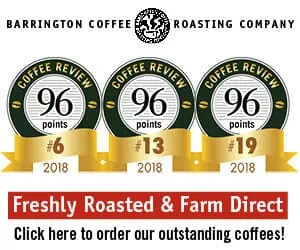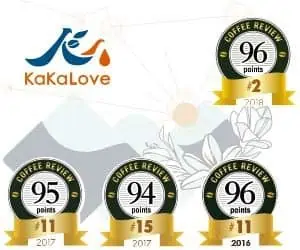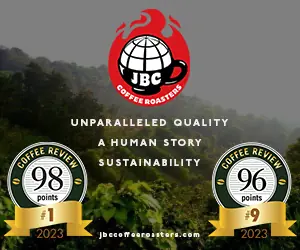Brazil is coming up in the world of specialty coffee. It probably always was up in Europe, where
Brazil’s finest coffees, sweetly rounded and low in acidity, anchored the continent’s leading
blends. In the United States, however, Brazil was mainly known for producing vast volumes of
cheap, mass-processed arabica coffees that found their nameless way into supermarket cans and
bottles.
Some years ago, however, a cadre of forward-thinking Brazilian coffee growers formed the
Brazil Specialty Coffee Association (www.bsca.com.br) and set out to simultaneously improve
the distinction and quality of their coffees while promoting them in consumer countries as
premium estate and regional origins.
They appear to be succeeding in both enterprises.
To find out how and why are succeeding, go to A New Brazil Cup?. To read a review of
the fruits of this success as they manifest in Brazil coffees for sale in North America, read on.
I cupped fifteen Brazil coffees from ten American roasters. When sourcing these coffees, I
tried to combine those that represented winners in the recent Brazil Cup of Excellence
competition, a competition designed to identify the finest Brazil green coffees (see A New Brazil
Cup?), with other coffees that represent a more traditional approach to high-quality Brazils.
As usual, I performed the cupping blind; i.e. the fifteen coffees were identified only by
three-digit numbers, and I matched the numbers to the coffees only after having cupped the table
twice in two different orders.
I was personally relieved to discover that the sequence of my preferences matched the
preferences of the international jury that selected the Cup of Excellence winners. True, my
ratings numerically were about three or four points higher than the international jury ratings, but
this can be explained in a number of ways, ranging from Ken Is Too Easy to the fact that I am
cupping these coffees in slightly darker, more fully developed production roasts than the lighter
“cupping” roast used for international cupping competitions. In the case of the Vargem Grande, a
competition coffee offered by two different roasters, the difference in my ratings between the
two versions directly relates to roast style. This delicate coffee seemed to fare much better in the
medium roast offered by Mr. Espresso than in Alpen Sierra’s somewhat darker presentation.
Finally, keep in mind that, unlike many cuppers, I am tolerant of mildly fermented or musty
tones if I feel they contribute positively to the cup.
Sadly, however, American coffee drinkers likely will never taste the coffees given the very
highest ratings by the international jury. Although the American roasters and dealers who bought
the prize winners represented in this cupping need to be saluted for their commitment to quality
and distinction, even these American coffee idealists pale in comparison to their Japanese and
European counterparts who forked out considerably more money per pound for the highest
rated competition coffees. For a list of prize winners and who bought what, go to
www.bsca.com.br.
A Different Cup
More interesting to me than the sequence of the prize winners, however, was how this cupping
seems to have confirmed the emergence what I am calling the new Brazil cup. I am not entirely
sure whether this new Brazil cup is necessarily better than the old Brazil cup, but it definitely is
different.
The old cup, represented by typical “Santos”-style Brazils, is sweet, round, low-acid and
low-toned, and likely to be complicated either by dry fruit tones or spicy, malty notes. It is a
dry-processed or “natural” coffee. Examples of this traditional Brazil cup in this month’s article
are the Brazil Fazenda Lagoa Natural from The Roasterie and the Fazenda Vista Alegre
Natural Dry from Intelligentsia Coffee Roasters.
The new Brazil cup, as suggested by the prize winning coffees, is also sweet, but it is at
the same time delicately acidy, with a subtle, high-toned complexity featuring citrus, floral, and
fresh fruit tones. It is this cup that impressed the preliminary jury for this year’s competition, of
which I was a member, and also, I am told, the subsequent international jury. This new Brazil
cup is a semi-dry-processed or “pulped natural” rather than a dry-processed coffee.
Only time will tell whether what I am calling (perhaps prematurely) the new Brazil cup
really is the new Brazil cup, or just a one-year anomaly. But the appearance of this cup was so
consistent during both the cupping trials and my much smaller sampling for this article, that I
figure it is at least worth a shot to identify it here and see what happens next year.
Caveat and Conclusion
Despite the novelty and intrinsic attraction of the new, the
old, lower-toned, dry-fruit Brazil cup is still a treasure, and remains irreplaceable in blends,
particularly espresso blends.
Plus one note of reservation: All of the pulped natural competition winners, the coffees I
am calling examples of the new Brazil cup, revealed at least a slight touch of bitterness in the cup
and astringency in the finish. This is the only reason these coffees did not, to my palate, merit
scores of 90 or higher.
But I am going to assume that these coffees, which are still relatively fresh, will lose this fresh crop
astringency as they sit in roaster warehouses and age a bit, and that,
courtesy of the Cup of Excellence, specialty coffee has just discovered another treasure to tease
and enchant us for years to come.

